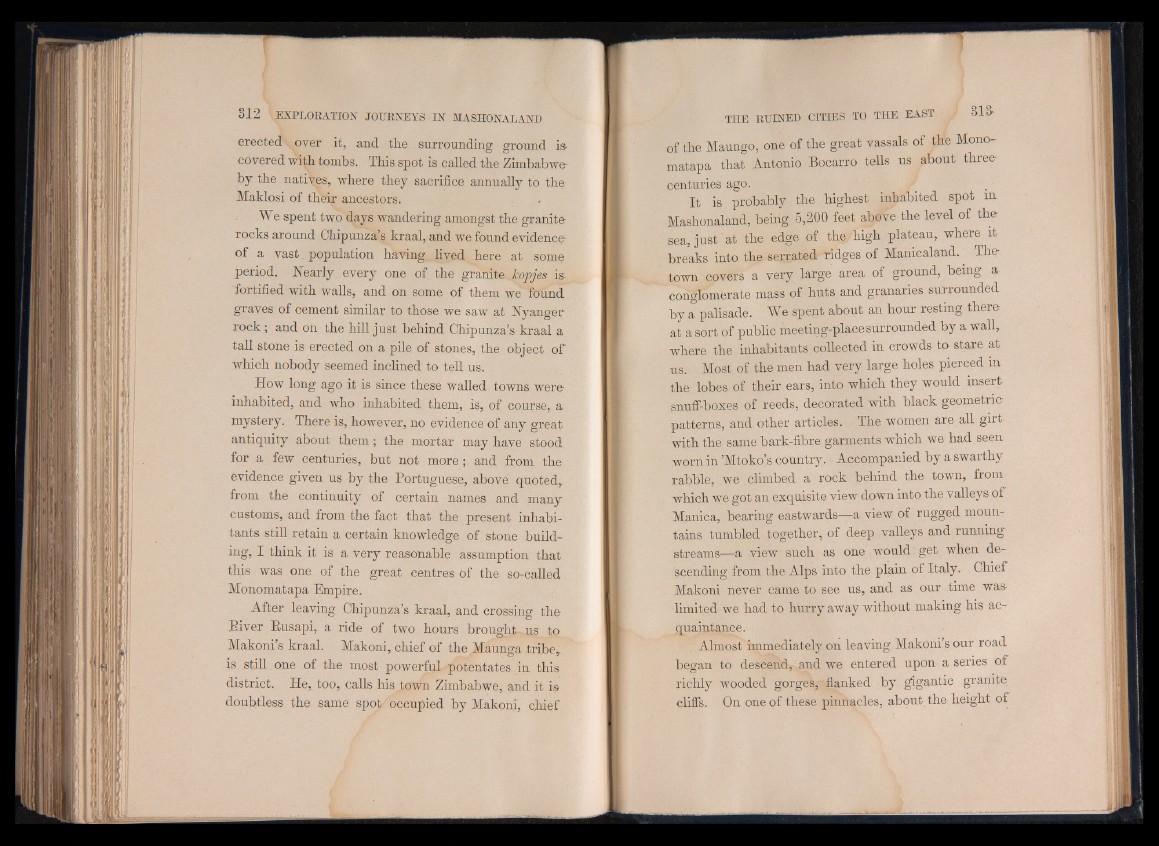
erected over it, and the surrounding ground is-
covered with tombs. This spot is called the Zimbabwe
by the natives, where they sacrifice annually to the
Maklosi of their ancestors.
We spent two days wandering amongst the granite
rocks around Chipunza’s kraal, and we found evidence-
of a vast. population having lived here at some
period. Nearly every one of the granite kopjes is-
fortified with walls, and on some of them we found
graves of cement similar to those we saw at Nyanger
rock ; and oil the hill just behind Chipunza’s kraal a
tall stone is erected on a pile of stones, the object of
which nobody seemed inclined to tell us.
How long ago it is since these walled towns were-
inhabited, and who inhabited them, is, of course, a
mystery. There is, however, no evidence of any great
antiquity about them; the mortar may have stood
for a few centuries, but not more; and from the
evidence given us by the Portuguese, above quoted,
from the continuity of certain names and many
customs, and from the fact that the present inhabitants
still retain a certain knowledge of stone building,
I think it is a very reasonable assumption that
this was one of the great centres of the so-called
Monomatapa Empire.
After leaving Chipunza’s kraal, and crossing the
Eiver Busapi, a ride of two hours brought us to
Makoni’s kraal. Makoni, chief of the Maunga tribe,
is still one of the most powerful potentates in this
district. He, too, calls his town Zimbabwe, and it is
doubtless the same spot occupied by Makoni, chief
of the Maungo, one of the great vassals of the Monomatapa
that Antonio Bocarro tells us about three
centuries ago.
It is probably the highest inhabited spot in
Mashonaland, being 5,200 feet above the level of the
sea, just at the edge of the high plateau, where it
breaks into the serrated ridges of Manicaland. | The
town covers a very large area of ground, being a
conglomerate mass of huts and granaries surrounded
by a palisade. We spent about an hour resting there
at a sort of public meeting-place surrounded by a wall,
where the inhabitants collected in crowds to stare at
us. Most of the men had very large holes pierced in
the lobes of their ears, into which they would insert
snuff-boxes of reeds, decorated with black geometric
patterns, and other articles. The women are all girt
with the same bark-fibre garments which we had seen
worn in ’Mtoko’s country. Accompanied by a swarthy
rabble, we climbed a rock behind the town, from
which we got an exquisite view down into the valleys of
Manica, bearing eastwards—a view of rugged mountains
tumbled together, of deep .valleys and running
streams—a view such as one would get when descending
from the Alps into the plain of Italy. Chief
Makoni never came to see us, and as our time was-
limited we had to hurry away without making his acquaintance.
Almost, immediately on leaving Makoni’s our road
began to descend, ,and we entered upon a series of
richly wooded gorges, flanked by gigantic granite
cliffs. On one of these pinnacles, about the height of